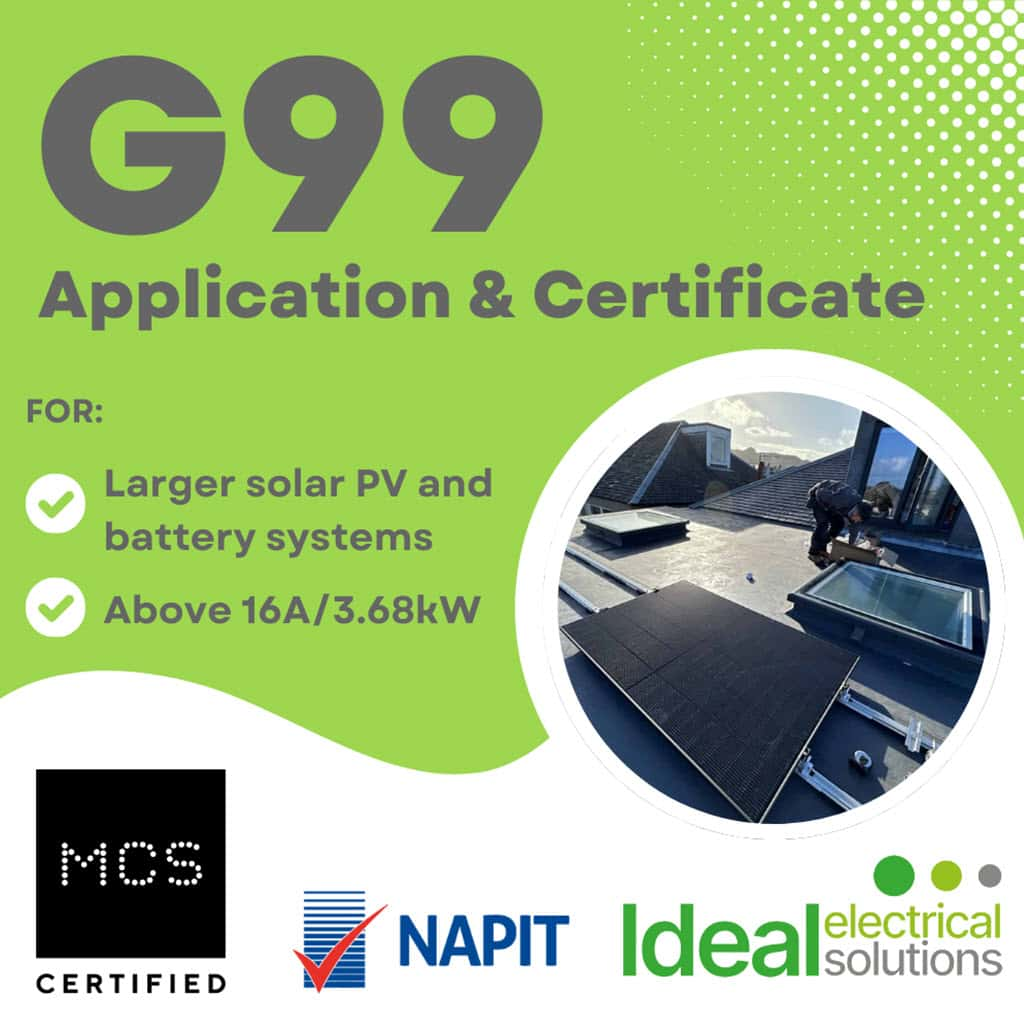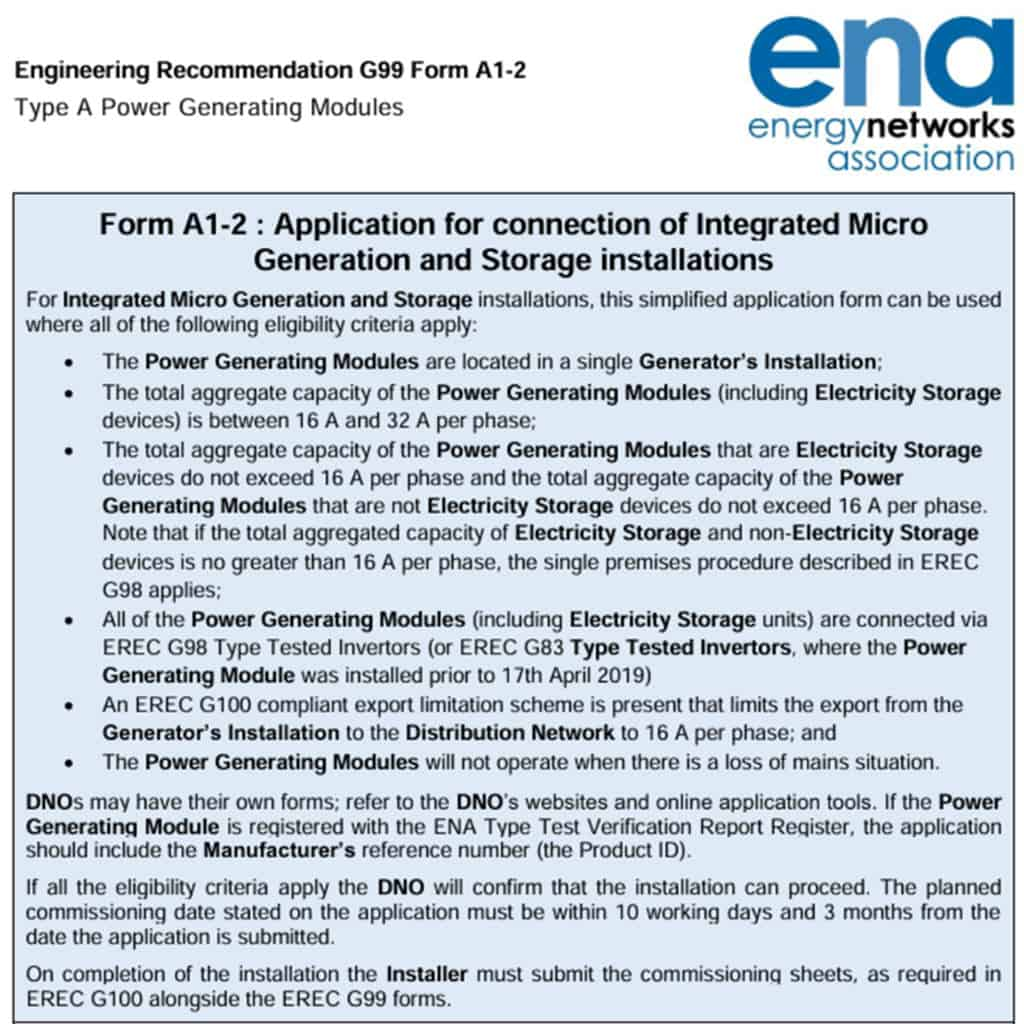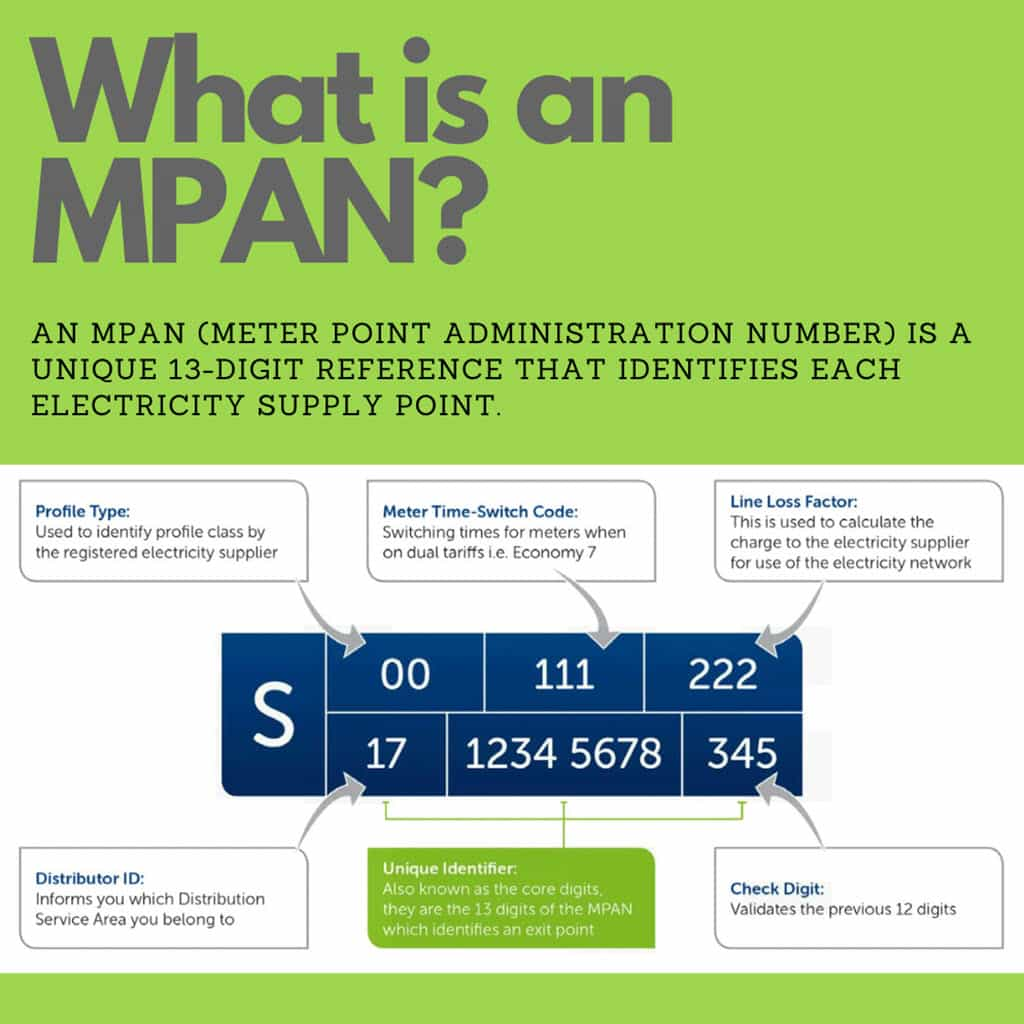Before any installation works for your PV solar system begin, you must have an approved G99 application in place. This is necessary to gain approval to connect your system to the national electricity grid.
If your system is below 3.68kW you can then submit a G98 application which formally notifies the DNO that the system is ready for connection.
Your installer will handle the G99 application before the installation and the G98 application once the installation is completed, providing you with the necessary certificates once issued
What is the difference between G98 and G99 applications?
G98 and G99 are the UK grid regulations, that give the safety standards and requirements for connecting solar PV, battery storage and other renewables systems to the electricity grid.
Put simply, the difference between a G98 and G99 application is:
- G98 applications are for smaller systems (below 16A per phase/3.68kW).
- G99 applications are for larger solar installations (above 16A per phase/3.68kW).
What is a G99 application?
The G99 application solar process is required for homeowners and businesses planning larger solar systems that exceed the 3.68 kW threshold. It is also necessary for systems integrating PV battery storage, particularly those exporting significant energy back to the grid. Hybrid systems, combining solar PV and battery storage, often require this application if their export capacity surpasses G98 limits.
If you are unsure whether your project needs a G98 or G99 solar application, the team at Ideal will help assess your requirements and provide guidance.
The G99 process begins with the design of your solar PV system, where we ensure all technical requirements for a G99 solar connection will be met. Next, we compile the necessary system details, including capacity, inverter specifications, and export limits, into an application for submission to the DNO. DNO means ‘Distribution Network Operator’, which in central Scotland will generally be Scottish Power Energy Networks (SPEN) or Scottish and Southern Electricity Networks (SSEN).
Once submitted, the DNO evaluates the system’s impact on the electricity grid. If any modifications are needed, we liaise with the DNO to make the required adjustments. After approval, your system is installed, inspected, and certified, completing the G99 application solar process.
When submitting your application to the DNO, we’ll need additional information from you, including a signed letter of authority, site plans, and a precise connection design prepared by our team.
Please note, there may be associated connection costs depending on the system size.
Smaller systems with a capacity of 16A per phase or less, typically equating to around 3.68 kW, fall under the G98 certificate solar process. This is a simpler application compared to the G99 and is designed for smaller-scale installations that have minimal impact on the local electricity grid.
How long does a G99 application take?
Approval times for G99 applications can vary, typically ranging from 10 to 45 working days.


G99 Fast Track application
The G99 Fast Track application is designed to streamline the approval process for larger renewable energy installations, such as solar PV systems, battery storage, and electric vehicle (EV) chargers, that exceed the standard G98 limits.
This fast-track route helps ensure a quicker and more efficient approval process for systems that need to connect to the grid while still complying with all technical and safety standards set by the Distribution Network Operator (DNO).
The G99 fast track route is ideal for projects that meet specific criteria and can demonstrate that the system won’t significantly affect the local network. The process involves submitting a simplified application with fewer technical assessments, speeding up the connection time while maintaining grid safety.
Once your system has been assessed and approved under the G99 fast track process, you’ll receive a certificate confirming that your installation is ready to connect to the grid safely and reliably. This allows you to begin generating and exporting renewable energy to the grid without unnecessary delays.
Why exports could be restricted under G99
When applying for solar, the DNO sets a limit on the amount of electricity that can be exported to the grid. They may require the installation of an export limitation device to prevent excessive energy from being sent back to the National Grid, ensuring it doesn’t overload the surrounding electrical infrastructure. This limitation is based on the capacity that the DNO determines is safe for the system.
If you are refused the full G99 allowance, we can adjust the inverter to match the export limit requested by the DNO. However, please note that this can only be done with certain manufacturers, as not all inverters are compatible with this adjustment.
G98 applications for smaller systems
For systems that qualify under G98, the application process is generally more streamlined and involves fewer technical assessments. Once your solar PV system is installed and operational, it will undergo testing to ensure it meets the standards outlined in the G98 regulations. If it passes the tests, you’ll receive a G98 certificate confirming that your system is compliant with grid connection requirements and ready to safely generate and export electricity.
This certification is often the preferred route for homeowners with smaller systems, as it simplifies the approval process while still ensuring compliance with both safety and technical standards. It’s important to note that G98 compliance ensures the safe integration of your solar system with the grid without compromising local electrical infrastructure.
The G98 route is typically quicker and more cost-effective for smaller systems, making it an attractive option for residential solar projects. However, for larger systems or those with specific requirements, the G99 application might be necessary. G99 involves a more detailed technical assessment and, depending on the system’s size, may require an export limitation device to ensure the grid is not overloaded.
If you’re unsure whether your system qualifies for a G98 certificate or needs the more in-depth G99 application, our team can assess your situation and guide you through the application process. We handle all the technical details to ensure a seamless, hassle-free experience for you. Whether you’re looking to install a small residential solar system or a larger commercial solar system, we’re here to help make the process simple and efficient.

You’ll also need an “export MPAN”
What is an export MPAN?
An export MPAN (Meter Point Administration Number) is a unique 13-digit reference number assigned to the export of electricity from a property. To be eligible to export renewable energy to the National Grid, you must have a Smart Export Guarantee (SEG) export tariff with your energy provider, and your property must be assigned an export MPAN.
Where can I find my export MPAN?
Your export MPAN can be found on your electricity bills. If you do not have one, your installer will need to complete the commissioning process. Upon completion, the DNO will issue the installer with the export MPAN, which will then be forwarded to you. It is important to register this MPAN within 12 months.
Summary and next steps
A G98 or G99 application and certificate gives approval to safely connect your solar PV and/or battery to the national electricity grid. A G98 application is for a smaller systems below 16A per phase/3.68kW. A G99 application is for larger installations above 16A/3.68kW.
For all renewables enquiries or for any additional information, please contact Mark using this enquiry form or call on 0131 258 2750. Alternatively, if you have a query (or have found this article useful) please do drop us a comment below.
Finally, you can find more information on the SP Energy Networks website. Or visit the National Grid website for info on connecting solar and wind and G99 generation.

